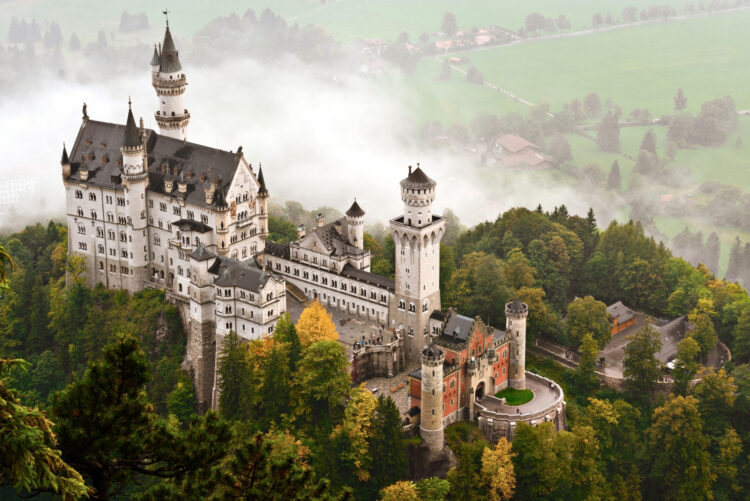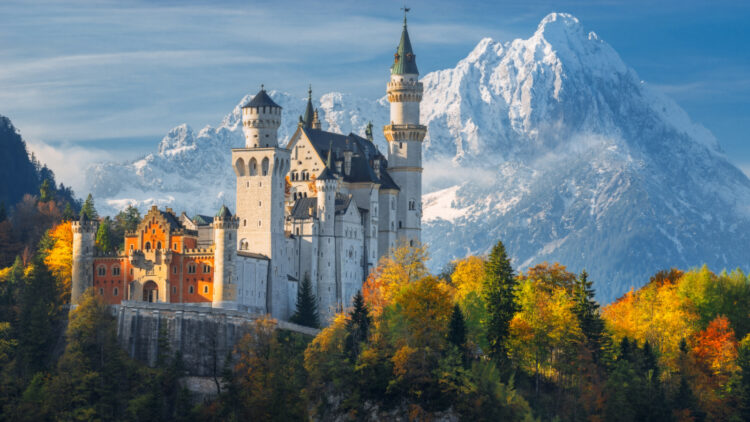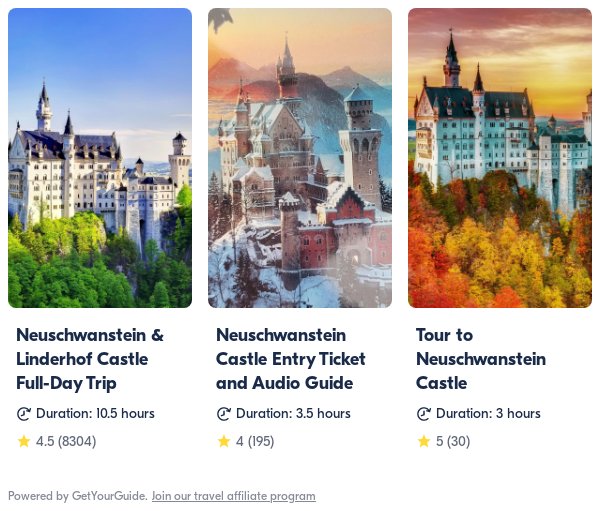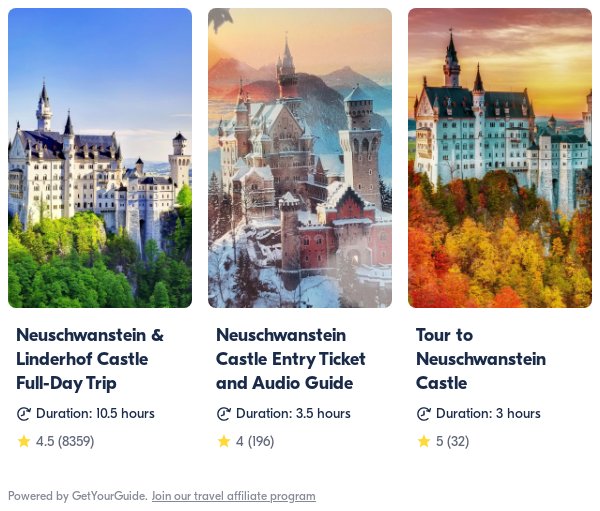Romantic Disney-like Schloss Neuschwanstein, one of Germany’s most-loved castles, is the top fairy tale castle of Bavarian “mad” King Ludwig II to visit and a popular day-trip destination from Munich and the Romantic Road.

Schloss Neuschwanstein near Munch is one of the top sights to see in Germany. For many visitors, it is a major reason for traveling to the Bavarian Alps. Few leave disappointed as Neuschwanstein Castle absolutely looks the part. Its medieval, neo-Romanesque looks are almost Disney-like being perched on a lonely rocky hill with the Alps in the background. The castle and its origins are wildly romantic while the natural setting is spectacularly beautiful too. Tickets are best reserved in advance, or book guided tours from Munich.
“Mad” King Ludwig II of Bavaria and Neuschwanstein
Bavarian King Ludwig II spent many happy childhood summers in Schloss Hohenschwangau — his father’s neo-Gothic fantasy castle in Schwangau. Here, surrounded by images of a romantic medieval past, he probably started dreaming of his own castles and palaces that would surpass any of the numerous similar projects that were popular in Germany during the 19th century.
Ludwig II became king of Bavaria in 1864, aged 21. In the fluid atmosphere of German and European politics of the mid-nineteenth century, the Bavarian king lost much of his sovereign power and by 1871 was basically powerless in a new united German Empire. The Bavarian King had little real ruling to do — this suited Ludwig well, as it allowed him to spend time on his fantasies of building romantic medieval castles. Contrary to popular belief, he spent his own money, not that of Bavaria, on his projects but being unmarried and without an heir led to his downfall and eventual removal from power.
Ludwig II, or Louis the Second, is often referred to in English as “Mad King Ludwig” — not so much for his fantasy castles but he was declared mad by the Bavarian authorities shortly before his mysterious death in 1886. In German, Ludwig II is usually referred to as the Märchenkönig (Fairy Tale King).
Construction of Schloss Neuschwanstein Castle near Munich
Schloss Neuschwanstein Castle is the best-known and most popular of King Ludwig’s buildings. His aim was to build an old German “Ritterburg” (knights’ castle) and as far as appearances are concerned, he clearly succeeded.
In 1869, the construction of Schloss Neuschwanstein in the historicist style popular in much of Europe during the nineteenth century started. The castle mixed Romanesque and Gothic elements into what King Ludwig thought a medieval castle should look like. He frequently changed his mind on the design and the interior is a real mess with numerous unusable staircases, blind alleys, and unreachable spaces.
Only around 20 rooms were ever completed but these have lavish decorations — mostly with scenes from operas by Richard Wagner. The Sängersaal (Singers’ Hall) has scenes from Parzival (Parsifal) and is based on a larger hall in the Wartburg near Eisenach in Thuringia. Both halls have fantastic acoustics and are occasionally used for concerts.
Schloss Neuschwanstein literally means Castle New Swan Rock (or Stone). The name only came into fashion after Ludwig’s death — he referred to it as the Neue Burg Hohenschwangau (New Castle Hohenschwangau).

Best Views of Disney-like Schloss Neuschwanstein Castle in Germany
Schloss Neuschwanstein looks absolutely stunning from the flats of the Lech Valley. Approaching the castle from the north, it is a beautiful white building on a small hill with the Alps in the background. It looks Disney-inspired and many think that Schloss Neuschwanstein inspired Walt Disney.
Even more spectacular are the views of Schloss Neuschwanstein from the mountains. The easiest way to enjoy seeing the castle from above is from the Marienbrücke — a small bridge that spans the narrow Pöllat River Gorge 45 m (148 ft) above a waterfall. It is an easy ten-minute hike from the castle to the bridge.
Visit Schloss Neuschwanstein Castle near Munich
The interior of Schloss Neuschwanstein Castle may only be seen on a compulsory guided tour of around 30 minutes (in German, often English, or as for an audioguide before the tour starts). Buying tickets for Schloss Neuschwanstein can be an ordeal — reservations are highly advisable.
Transportation to Schloss Neuschwanstein is easy by train from Munich or on day-trip tours. Although tickets for the castles are often not included in tour prices, the organizers may be able to secure tickets on busy days.
Other nearby sights include Schloss Hohenschwangau, Oberammergau, Schloss Linderhof, die Wieskirche, and the Romantic Route (Romantische Straße).
More on King Ludwig’s Castles and Palaces
The three fantasy castles of King Ludwig are all near Munich and are popular day trips whether on bus tours, driving, or using public transportation. Schloss Neuschwanstein and Schloss Linderhof are to the southwest and may be seen on the same day when driving or on tours. Schloss Herrencheimsee is to the southeast and also a good stopover en route to Salzburg.
Savings Deals in Bavaria:
- Visit Mad King Ludwig’s Fantasy Castles Near Munich in Germany
- Save on Top Sightseeing Site Tickets in Bavaria, Germany
- Save with the Bayern Ticket on Public Transportation — Buy the Bayern Ticket Online from Deutsche Bahn, or consider the €49 Deutschland-Ticket.
- Book Day-Trip Tours from Munich
Schloss Neuschwanstein and Schloss Hohenschwangau:
- Buy Tickets for Schloss Neuschwanstein and Hohenschwangau Castles
- Transportation to Schloss Neuschwanstein
- See Romantic Disney-Like Schloss Neuschwanstein Castle
- Visit Schloss Hohenschwangau in Bavaria, Germany
- Top Sightseeing Sites in Füssen and Schwangau
- Book Day-Trip Tours from Munich to Schloss Neuschwanstein
Schloss Linderhof:
- See Schloss and Park Linderhof in Bavaria, Germany
- Visiting Schloss Linderhof: Opening Hours, Tickets, and Transportation
- Book Day-Trip Tours from Munich to Linderhof
Schloss Herrenchiemsee:






